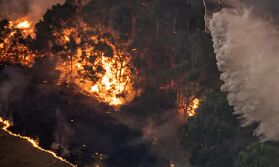Heating up

In the history of Australia, bushfires and indeed extremely destructive bushfires are not entirely uncommon. Australia has a varied bushfire season that tends to differ across different areas due to weather patterns. Still, the hot, dry and drought-prone climate of Australia means that throughout the year, some parts of Australia have an increased fire hazard. It is known that indigenous Australian tribes have their own ways of controlling and using this fire hazard in a method referred to as fire-stick farming. This method is now being reintroduced in several parts of Australia as part of a wildfire threat reduction system.
What has changed in the last century is the frequency and scale of such fires. Several studies have shown that due to Australia's climate warming by more than one-degree Celsius over the last century has meant that Australia is presently seeing some of the hottest and driest weather that the nation has on record. In fact, 2019 was noted to be the driest year in Australia since 1900. The signs of change were always present but it was the sheer ferocity of the 2019 fire season that finally forced Australia's administration to admit that signs did indicate that global warming was possibly aggravating the destructive potential of the bushfire season. While the loss of life and economic damage was indeed unprecedented, recent reports have shown that effects on local wildlife were equally devastating. WWF Australia recently released a report that stated that more than 61,000 koalas and almost 143 million other native mammals were in the path of the 2019-2020 fire. This is an addition to the 2.46 billion reptiles who were also affected by the fire spreading. Experts say that even if many of these animals avoided the grim fate of being burnt to death, they now face a subsequently higher risk of death due to injuries or deprivation of required resources. The destruction of the ecosystem was quite brutal with reports estimating that trillions of arthropods and hundreds of millions of fish were also being affected by the apocalyptic fires. 2019 swiftly gained notoriety as the worst fire season on record for Australia and became the face of the larger climatic devastation that could affect the nation in the near future. Reports of irreversible damage to the Great Barrier Reef, increased year by year propensity of droughts, etc., create a picture of Australia that supports the scientific theory that Australia will likely be the first place on earth to produce climate change refugees.
The 2020 fire season which is now ongoing has not given encouraging signs. In October, a blaze started by an illegal campfire started a bushfire that has now burnt through half of Fraser Island, an island that is 250 km north of Brisbane and is listed by UNESCO as a 'World Heritage' site. Authorities have asked residents of the island's Happy Valley to evacuate immediately as the fire continues to burn. Residents have been warned that the fire department may not be able to prevent severe destruction of property and infrastructure if and when they lose control of the blaze. For fire experts, the Fraser Island fire is particularly worrying as it is highly unusual in scale, intensity and timing. There are fears that there may be a repeat of the 2019-2020 fire season, the damage estimates for which are still ongoing. More importantly, the fire outbreaks have increasingly shown that relying on the past precedent of weather patterns to understand the current changes is no longer relevant as climate change makes the whole process more erratic.
The Scott Morrison government has typically tried to dodge the correlation between human activities, climate change and Australia's increasingly severe climate crises. In large part, this is due to the significant role of the mining industry and other related sectors in the Australian economy. Last year's devastating 'Black Summer' may see a significant shift to that stance. A report presented to the Australian Government on bushfires noted that continuing climate change will have a marked impact in exacerbating extreme weather conditions. The report made 80 recommendations and called for the Government to recognise the unambiguously grim nature of the predictions. For its part, the Government has pledged to carefully consider the proposals but whether this results in a significant action plan remains to be seen.



